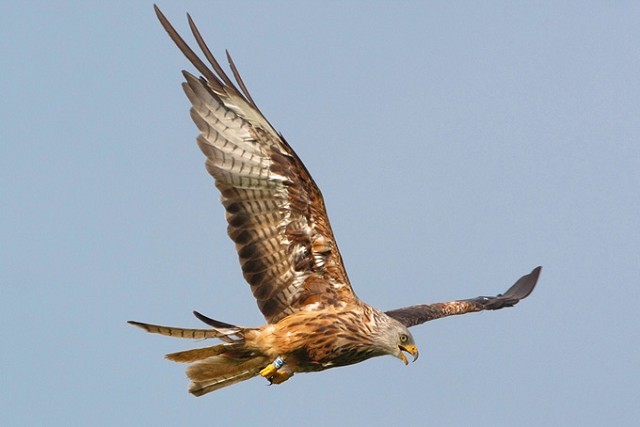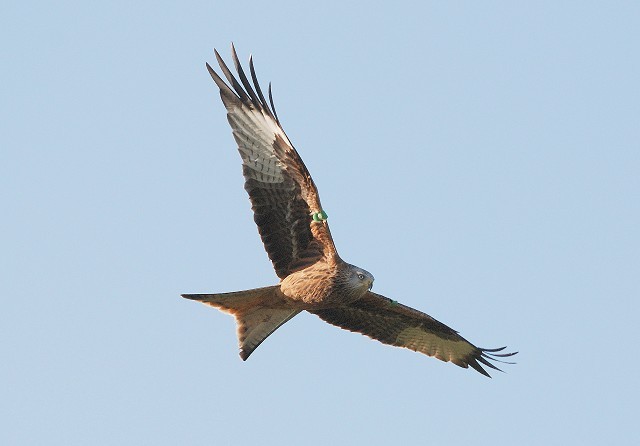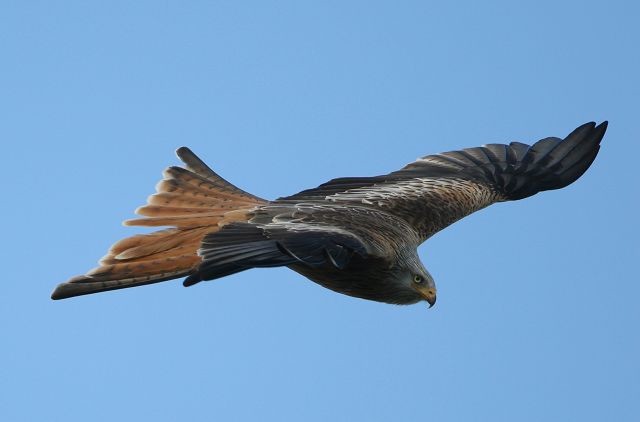Red Kite numbers are soaring across the UK
A survey of the birds has revealed the Scottish population is now at its highest level for 200 years, following one of the best-ever breeding seasons and an ongoing reintroduction project around Aberdeen. Numbers have also doubled in northeast England over the last year and increased by more than 40% in Yorkshire.

Red Kite, Gigrin Farm, Powys (Photo: Nigel Pye)
Red Kites continue to thrive in Wales and in their English strongholds of the Chilterns and Rockingham Forest in Northamptonshire. This summer also saw 27 of the birds reintroduced into Northern Ireland for the first time in two centuries. The Scottish population now stands at 122 breeding pairs, with the UK population as a whole growing to an estimated 1,200 breeding pairs.
Red Kites were once common across the British Isles before they were all-but wiped out by widespread killing in Victorian times. By the 1930s there were just 10 pairs left in a remote part of Wales. By the mid-1980s, there were still fewer than 100 pairs. In 1989, a UK reintroduction project began in the south of England and the north of Scotland, helped greatly by the progressive attitudes of many of today's landowners.
The fruits of this labour are now being seen and the UK population is becoming increasingly important as land use changes and illegal poisoning and rodenticide poisoning cause declines in its main breeding areas of Germany, France and Spain. Red Kites are now classified as "near threatened" by the World Conservation Union and the UK's 1,200 pairs represent around 5% of the world population.
Dr Mark Avery, RSPB Director of Conservation, said: "The continuing recovery of the Red Kite is a fantastic success story. It is a truly iconic bird and wherever it has been reintroduced, from the Chilterns to Gateshead to Aberdeen, local people have taken it to their hearts. Its return is a testament to what is possible when all sectors of society, conservationists, landowners and the general public, recognise the value inherent in our wildlife and work together to protect and treasure it. As a country, we can be very, very proud of what has been achieved over the last 20 years."

Red Kite, Laurieston, Dumfries & Galloway (Photo: Jim Woods)
Highlights of the 2008 season have been:
- In north Scotland, there were 46 breeding pairs of Red Kites, which fledged 82 young. This is the first real population increase since 2001 and is a heartening development.
- In northeast England, the breeding population doubled from 11 pairs last year to 23 pairs this year. This also led to a doubling in the number of young fledged from 11 to 22.
- In Yorkshire, the number of breeding pairs increased from 47 to 67, with the number of young fledged rising to 115 compared to 79 last year.
- In central Scotland, 45 breeding pairs fledged 75 young. This is a substantial increase of 11 breeding pairs on last year's total, with particular population increases in west Perthshire.
- In Dumfries and Galloway, 30 breeding pairs fledged 53 young, and this was an increase from 21 pairs with 38 young in 2007. A kite from the 'indigenous' Welsh Red Kite population was involved in one of these pairs—the first confirmed occurrence of a Welsh Red Kite breeding in Scotland, and a sign that the UK population is mixing and recovering strongly.
- The first breeding attempt by a pair of Red Kites on the edge of Aberdeen city. These birds were only a year old, having been released in the area last year in the first of a three-year reintroduction project. Red Kites usually do not breed until they are 2-3 years old and, unfortunately, the eggs did not survive due to the immaturity and inexperience of the birds. However, this represents the first time Red Kites have bred in this area for 150 years or more. In 2008, the second year of the Aberdeen reintroduction, a further 35 birds were released.
- Interestingly, a bird initially released in Galloway in 1991, and which bred for 2-3 years in central Scotland, has now returned to breed successfully in Galloway in 2008. This is the first time that such a return movement of an established breeding bird to breed in its release area has been recorded.

Red Kite, Lower Benefield, Northamptonshire (Photo: John Peacock)

